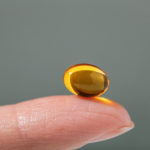By David Blyweiss, M.D., Advanced Natural Wellness
February 6, 2012
- Vitamin classifications and why they matter
- The when, where and how of taking supplements
- Understanding possible interactions and staying safe and healthy
For most of us, the easier we can make our daily routine, the more likely we are to stick with it. But the easiest way to take your supplements might not be the best way.
Vitamins, minerals and herbal remedies fall under different categories, and they each require different environments to be absorbed. Most of the time, you can and should take them with food. But there are exceptions.
Today, I’m going to give you some of the “whys” behind the recommendations, and some specific guidelines for when to take your supplements. It may require a variation from your current usual routine – but it might also greatly improve your chances of getting the full health benefits from everything you take…
You may have heard vitamins are categorized as either: fat-soluble or water-soluble. This is an important distinction.
The fat-soluble vitamins include vitamins A, D, E and K. These vitamins need fat in order to be absorbed, so they should always be taken with meals that contain fat.
I know, in our lowfat-obsessed culture, this may sound like heresy. But it’s true. And that’s why it’s also important to understand the difference between “good fat” and “bad fat.” So, a little olive oil on your gluten-free toast in the morning, topped with a couple slices of avocado, creates an excellent environment for absorbing your morning multi-vitamin.
Open your arteries, improve blood flow for a new health miracle...
Did you know your circulatory system has over 60,000 miles of arteries, veins and other blood vessels, if stretched end to end?
But as you age, your blood vessels undergo changes, which may cause them to stiffen, thicken and get clogged.
GOOD NEWS! Doctors have now identified a “Miracle Molecule” inside your arteries that helps OPEN your arteries and IMPROVE blood flow.
It’s what Dr. Valentin Fuster calls it, "One of the most important discoveries in the history of cardiovascular medicine."To you, that means...
- Healthy blood pressure
- Sharper mind and memory
- Skyrocketing energy and muscular strength
- Increased pleasure and passion in the bedroom
- Improved circulation to every cell and organ in your body
Go here to discover a new natural way to significantly boost the levels of this miracle molecule in YOUR body NOW!
Fat-soluble vitamins are also stored in fat, so it is possible that if you take higher or mega-doses of these, you could have too much in your system, causing a condition called hypervitaminosis.
Some pharmaceuticals can also cause difficulty with supplement absorption, so it’s important to tell your physician everything you take and at what dosages.
We don’t see a lot of deficiency in fat soluble vitamins in this country – with one exception: Vitamin D. Most of us simply don’t get enough sun, and it’s having dire consequences on our health.
You can take as much as 10,000 IU a day for about 4-6 weeks, but then you’ll want to taper down to 5,000 IU a day depending on your tested blood levels. After six months of supplementing with Vitamin D, you should get re-tested.
And once your levels are back up, you can drop back to a maintenance dose of 1,000 IU a day. Since vitamin D is fat-soluble, your body is able to retain enough to keep your levels in a normal range – once you resolve the deficiency.
This guideline remains true even if you are taking a liquid form of these vitamins.
While it’s true pills can require food to initiate enough stomach acid to break the pill down and release the vitamin into your system – fat-soluble vitamins must be taken with some fat in order to be effective, no matter what form they are in.
Are You Suffering From...
- Love handles and a pot belly
- Romance that isn't what it used to
- Forgetfulness and inattention
- Low (or no) strength and endurance
- A sex drive that's shifted into neutral...or worse
If so...you may have Mature Male Burnout. Click here to discover more about this unique condition and what you can do about it.
Water-soluble vitamins include the entire B-complex, and vitamin C. Water-soluble means they do not require fat in order to be absorbed, and they are also not stored by the body and need to be replenished daily.
You can still take your B’s and C with meals, but it isn’t required that you do so in order for it to be absorbed. Also, B vitamins require an acidic environment to be absorbed, so if you take antacids or any medications that reduce stomach acid, you may not be absorbing what you’re taking. But taking them with a glass of orange juice is generally enough to do the trick.
Vitamin C only lasts for a few hours in the bloodstream. splitting your daily dose up into two or three doses – or even taking it every few hours throughout the day – is a good idea. And both the B’s and C are considered stimulating vitamins, so you should not take them too close to bedtime.
In addition to these main vitamins, I often recommend other supplements, such as herbs, amino acids, and probiotics. So, let me demystify how to take those, as well…
In many cases, additional anti-oxidants are finding their way into multi-vitamin blends, such as resveratrol, lutein, zeaxanthin, etc.
This trend reflects the research that’s emerged in recent years showing how important antioxidants are to cellular health. You can follow this general rule: Taking supplements with food is best, but always read the label for exceptions before you incorporate something new into your supplement regimen.
Whether you are taking supplemental fiber, or including high-fiber foods in your diet, it is best to incorporate them first thing in the morning. Even before you take your supplements.
This gives the fiber a chance to make it to the colon and start to work, without impeding the absorption of your other vitamins and supplements.
Most herbs are best taken on an empty stomach. Either 20 minutes before or a few hours after a meal. For example, a natural sleep-aid including melatonin with relaxing herbs can be taken before bed without any food. But if herbs are included in a mixture that has fat-soluble vitamins, you should take with food.
And finally – let’s look at probiotics – the key to absorption of both food and supplements. You can take your probiotics with, or just before, a meal. But I don’t advise waiting until after, when you are full. Getting them into the digestive system just ahead of a meal gives them a chance to work when they are needed most.
One of the easiest ways to simplify even complicated supplement schedules is to get a pillbox to separate not only by day, but by time of day. You can also use a watch or phone for reminders throughout the day of when to take what you need.
A few minutes preparation, either in the morning or at the start of the week, can ensure you take the recommended doses and remember to get everything in that you need.
Store your box in a cool, dry – but visible – place.
The one complication can be remembering to take the refrigerated supplements, such as fish oil and probiotics. Keeping these close to something you grab for regularly, or on a very visible shelf, might be the best remedy for forgetting them.
Something else to remember: interactions are possible – especially between supplements and pharmaceuticals. If you take both, double check with your doctor.
And if you are trying to use supplements as a way to gradually reduce your use of pharmaceuticals, work with a physician who is knowledgeable of both, and who shares your goal.
References: Schmidt DR, Regulation of bile acid synthesis by fat-soluble vitamins A and D. J Biol Chem. 2010 May 7;285(19):14486-94. Epub 2010 Mar 16.
Haller J., The vitamin status and its adequacy in the elderly: an international overview. Int J Vitam Nutr Res. 1999 May;69(3):160-8.
Said HM., Intestinal absorption of water-soluble vitamins in health and disease. Biochem J. 2011 Aug 1;437(3):357-72.






